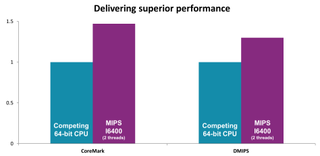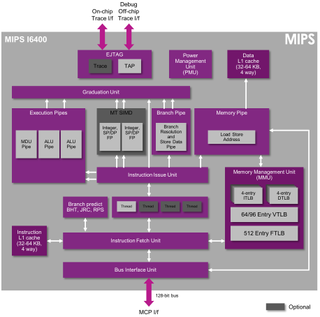Imagination's MIPS64-Based I6400 CPU Takes On The 64-Bit Competition

Today, Imagination is announcing the I6400, its first mobile 64-bit CPU based on the MIPS64 instruction set. The new CPU is meant to compete on equal footing against the new 64-bit ARMv8 processors on the upcoming Android L platform as well as Intel’s upcoming x86-x64 Atom processors.
Android L not only brings specific compatibility for these new 64-bit instruction sets, but for the first time ever, it also offers native compilation for the underlying CPU architecture of the device in use. All apps -- not just C++ apps -- will compile natively on MIPS CPUs as well as on ARM and x86 CPUs. That means no more emulation will be needed for the MIPS architecture for the majority of Android apps. All will run with no handicap compared to ARM.
Since Android now happens to be the fastest growing mobile platform (and soon the one with the highest install base, too) this presents a huge opportunity for the MIPS architecture to provide real competition to the ARM and x86 architectures. This should be good for Imagination, but most importantly it will be good for consumers, too.
Intel (the only one currently representing the x86 ISA on mobile) has its own vision about mobile chips, as does ARM and some of its partners who make their own custom CPU cores, but Imagination will have yet another. When all of these visions clash (hopefully) the best of the best of these chips will come out on top, and the consumer will be better off for it.
When Imagination acquired MIPS technologies, many people were excited because Imagination was the leading mobile GPU provider and they wanted to see what Imagination could do with an ISA and CPU it can shape however it wants. Imagination also needed its own CPU core (either ARM or MIPS), because we’re seeing a trend towards higher integration in the chip business with chip makers owning both CPU and GPU IP.
With the Heterogeneous Systems Architecture arriving on mobile (which Imagination supports), that integration will only matter more and more in the future, and Imagination could be at a disadvantage if it doesn’t have its own CPU, too.
While the MIPS ISA has had support for 64-bit computing for a long time (since 1999), it hasn’t had that support on mobile; only now we’re beginning to see mobile chip makers on all three main platforms launch their 64-bit chips.
Stay on the Cutting Edge
Join the experts who read Tom's Hardware for the inside track on enthusiast PC tech news — and have for over 25 years. We'll send breaking news and in-depth reviews of CPUs, GPUs, AI, maker hardware and more straight to your inbox.

The I6400, Imagination’s first mobile 64-bit CPU, seems to be from its InterAptiv mid-range class of chips, while the P-class consists of the high-end “Warrior” CPUs, which are still on MIPS32. The fact that it’s also dual-issue in-order design tells us that it’s meant to be a mid-range chip.
The MIPS architecture has been fighting an uphill battle against ARM in the mobile space for even longer than Intel’s chips have. The reason Imagination might launch a mid-range 64-bit chip first is because it wants to maximize the chip’s potential for success, especially in places like China, where price and price/performance is a much bigger consideration than pure performance.
Despite being a mid-range chip, the I6400 should give its competitors a run for their money. The chip has MIPS’ natural efficiency advantage over ARM, which allows the chip to have higher performance at the same area or the same performance on a smaller area (with smaller costs).
The I6400 core is only 1x1 mm large, which is twice the size of a Cortex A7, but 2.5x smaller than a Cortex A15 (their 64-bit successors, Cortex A53 and Cortex A57, should have similar sizes). Its die size is right between the two, while offering higher than mid-range performance. The chip reaches a higher performance for its class in part because of the MIPS instruction set’s advantages, but also because it has something no ARM chip has yet -- simultaneous multithreading (SMT).
The support for SMT allows the I6400 to have not just two threads per core, as Intel’s chips do, but up to four threads per core. Imagination claims one extra thread adds up to 40-50 percent increase in performance, which is achieved only with 10 percent extra die space. However, for each extra thread, the performance will see diminishing returns, much like when adding extra CPU cores to a chip.

The CPU can also come in clusters of up to 6 cores, but using multiple threads per core can save cost on each extra core for the OEM customer. An OEM shouldn’t need to buy more than a dual-core version for most of its products; if one wants to use the chip at the low-end, it could buy only one core with two or four threads enabled. This could prove a significant advantage even over the low-cost ARM cores, especially in a market like China. The I6400 can also come in configurations of up to 64 clusters, but that seems more like something a server would need than a mobile device.
The I6400 MIPS core also has features such as 128-bit SIMD support, hardware virtualization and multiple independent security contexts, which can better secure mobile payments and identities and protect user privacy. The MIPS Release 6 architecture, on which the CPU is based, also comes with some new instructions to accelerate JIT, Javascript engines and general browsing performance. It should be interesting to see how much better it does in browser benchmarks that usually test a CPU’s performance.
Imagination’s entrance in 64-bit mobile computing seems to be a solid although slightly disappointing one, which has more to do with the fact that it doesn’t yet have a high-end 64-bit CPU that we could see in something like a Galaxy S6 or HTC M9 early next year. The I6400, although of high performance for its class, looks more suited for a Moto G or a higher-end Chinese phone that you can get for half the price of a Samsung or Apple flagship phone.
On the other hand, it’s understandable why Imagination went this route; it wanted maximum potential in terms of volume. However, if Imagination wants to compete with the likes of Nvidia’s Denver, Apple’s A8 or Qualcomm’s latest high-end CPU, it will need to release a P-class MIPS64 CPU as soon as possible -- and it should be at 20nm if released early next year, or 16nm FinFET if released late next year.
That’s what will make the world pay attention to Imagination when it comes CPUs, but even more importantly, to the MIPS architecture which needs to fight hard for every 1 percent of the market it can take from ARM. This is not to mention that MIPS also has to deal with Intel and its even more advanced process technology.

The I6400 offers 64-bit computing at the mid-range, some new innovations such as support for up to 4 threads per core, and probably the best performance for your dollar of any mobile chip, at any range. That should be enough for now to give OEMs a taste of what MIPS64 chips can do and pique their interest in a future MIPS64-based P-class high-end CPU core that we’ll be eagerly awaiting to appear.
Until then, the I6400 is already available for licensing and is expected to appear on the market this December, while developers can begin trying it right now in the QEMU open source emulator.
Follow us @tomshardware, on Facebook and on Google+.
Most Popular



